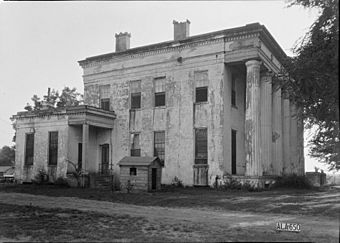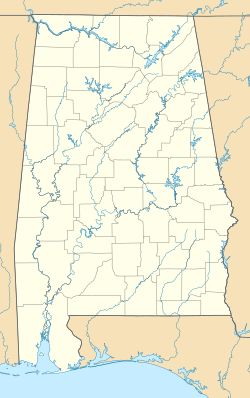Stone Plantation facts for kids
|
Stone Plantation
|
|

Side view of the main house in 1937, prior to restoration
|
|
| Nearest city | Montgomery, Alabama |
|---|---|
| Area | 2.8 acres (1.1 ha) |
| Built | 1852 |
| Architect | Barton Warren Stone |
| Architectural style | Greek Revival |
| NRHP reference No. | 01001411 |
Quick facts for kids Significant dates |
|
| Added to NRHP | December 31, 2001 |
The Stone Plantation, also known as the Young Plantation or the Barton Warren Stone House, is a historic home near Montgomery, Alabama. It is built in the Greek Revival style. This style was popular for grand houses in the American South. The main house and one other building still stand along the Old Selma Road.
The Stone Plantation was added to the Alabama Register of Landmarks and Heritage on September 28, 2000. It was also added to the National Register of Historic Places on December 31, 2001. These lists help protect important historic places.
Contents
History of Stone Plantation
The main house is a two-story building made of brick. It was built around 1852 by Barton Warren Stone. The front of the house has a large porch with tall, round columns. This style is called a Doric hexastyle portico.
Who Was Barton Warren Stone?
Barton Warren Stone was born on March 24, 1800. His father was Warren Henley Stone from Poynton Manor in Charles County, Maryland. His mother was Martha Bedell from North Carolina.
In the 1830s, Barton's parents started a plantation called "Magnolia Crest." This plantation was in Lowndes County. It is still standing today, just a few miles from the Stone Plantation.
Stone's Plantations and Land
Barton Stone owned three plantation houses. His family called the Stone Plantation simply the "Home Place." His other two houses were named "Duck Pond" and "Prairie Place."
By 1860, Barton Stone owned a very large amount of land. He had about 5,000 acres (2,000 ha) in Montgomery County. He also owned another 2,000 acres (810 ha) in Autauga County. Like many large farms at the time, these plantations relied on the labor of enslaved people.
Barton Stone lived a long life. He outlived two of his wives and all but one of his sons. He passed away on January 14, 1884.
Later Owners of the Plantation
After Barton Stone died, the property changed hands. L.C. Young bought the Stone Plantation in 1901. Later, in 1933, Jesse D. Baggett acquired the property.



